 |
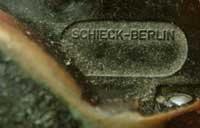 |
German WWII marching
compass. For description go to the manufacturers Breithaupt and Busch. |
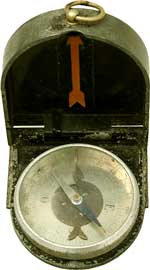 |
 Radium-compound paint marking of magnetic North |
 Technical Data - See Modčle 1922 - Divisions: 400 grades - S/N: 1644 |

 Click on the images for enlarged views |
 |
NOTE: The fig. at left are taken from the Swiss version of the patent and offer more details than the Swedish original |
 Picture G. Perry |
Marching
compass Verner's
pattern Mk VII with manual transit lock. Compare with the French Ltd (F-L) compass Verner's pattern Mk VIII with automatic transit lock. A facsimile of the original. User Instructions can be ordered. (Click HERE to see a photograph of page one). |
Technical
Data - Diameter: 54 mm - Depth: 21 mm - Weight: 150 gr - Card material: aluminum - Date: 1915 |
 Concerning the black star-shaped line in the lid, see Major LEGH's compass. |
THE MAGNAPOLE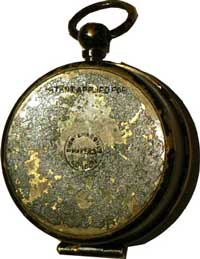 This version is the very first draft and a provisional design (Patent applied for) In the center: SHORT & MASON Ltd MAKERS, LONDON. |
Technical
Data - Diameter: 50 mm - Depth: 20 mm - Weight: 140 gr - Pouch: Leather - Divisions on compass card and inside the lid (marching course setting) : 360 deg., clockwise  The patents' figures (click for detailed view) 
|
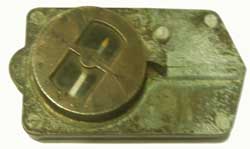 Swedish
company (for more information click HERE).
See also Gunnar TILLANDER.
SILVA bought SISTECO in 1990 and produced their model Mark IV.
The earlier compasses were marked AB. BRÖD. KJELLSTRÖM (Kjellström
Brothers Co.). The brothers' names Björn and Alvar appear on a patent
filed in 1936 (link
to pic of page 1).
Swedish
company (for more information click HERE).
See also Gunnar TILLANDER.
SILVA bought SISTECO in 1990 and produced their model Mark IV.
The earlier compasses were marked AB. BRÖD. KJELLSTRÖM (Kjellström
Brothers Co.). The brothers' names Björn and Alvar appear on a patent
filed in 1936 (link
to pic of page 1).| List of SILVA models in a French
flyer
(1970s ?) Only five models (types) are described. Click on the image for the technical data of each model. |

|
The
oldest model "Typ 1" dated
1933 
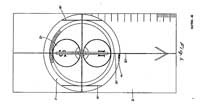 Picture courtesy SILVA Drawing at r.: French patent issue no. 782.657 (s. Gunnar TILLANDER) and British Patent no. 445,312 |
Model
"Typ 1 - 400 / 6300" probably early or mid 1930s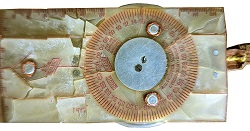
The disc on obverse is divided into 6300 MILS The patents no. 90828, 91435 and 95397 are the early Swedish versions Picture courtesy K. Lubos |
Model
"Typ 1
- 400" probably early 1970s The patents no. 94784 and 99350 are the early Swedish versions Picture courtesy H. Waldmann |
Model Typ 2
dated 1930s (?)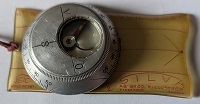
This instrument is marked "World patent" without numbers and features the SEIC logo. Pictures courtesy K. Lubos |
Underside Like on Typ 1 there is a disc divided into 400 grades on the obverse |
Model
featuring a bezel with Swedish cardinals (West = V; East = Ö) and
divided into four times 50 degrees with the zeros facing north and
south. The pouch was shaped to accommodate for the higher capsule.
|
Model Typ 2 - 1970s
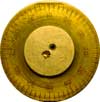
The disc on obverse is divided into 6000 MILS Picture courtesy S. Lamb |
Type
2 model
featuring a bezel with Swedish cardinals and divided into 6400 MILS
with
a disc divided into 400
grades on the obverse like Typ 3 Picture courtesy H. Waldmann |
|
Model Typ 3 Pictures courtesy L. Karolewski |
Model
"Typ 3
- 400"  Disc on obverse: 400 grades division |
Model Typ 4 (?) We could not find an early TYP 4. The first model TYPE 4 known appeared much later. Currently available items in 2024 are 4, 4 S, 4/54 Expedition and also decommissioned French and British Army instruments. NOTE: The model TYPE 4 S displayed below features a prism and a magnifying glass (pic. courtesy T. Flynn) . |
Model Type 4 featuring a prism
and a round magnifying glass |
Model Type 4 S, prismatic with
square magnifying glass and additional ruler Foto T. Flynn |
User instructions for Typ 4
S and Polaris
7NL: |
| Military
Model Expedition Type
4-54 (British Army) - Current models are designated EXPEDITION and some feature a sighting prism 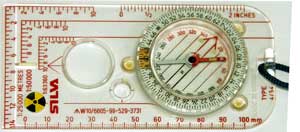 Technical Data - Self luminescent markings (Tritium compound paint) - Dimensions: 124 x 60 x 10mm - Divisions: 6400 mils, clockwise - NATO Stock Number (NSN): W 10/6605-99-529-3731 - Three Romer scales, one for the British military maps (1:63360, 1 inch = 1 mile) (pic. court. L. Karolewski) |
Military
issue for the French Army and/or Légion Étrangčre (no model name
or type no.)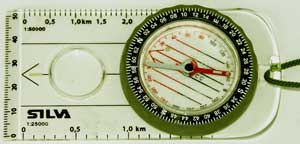 Technical Data - Self luminescent markings - Dimensions: 124 x 60 x 10mm - Divisions: 6400 mils, clockwise - Two scales, military green soft rubber bezel cover - NOTE: On the obverse face, abbrev.: MN - C.C. (link to pic.) = magnetic north in red and compass course in black on the red and black arrow |
|
| Model Typ 5
'Skolkompass' (see also the version for Girls Scouts below)  
|
Model Typ 5 Skolkompass
Box Pictures courtesy H. Waldmann |
Model Type 5
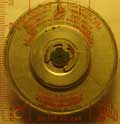 |
| Model
"Typ 6 -
400" - SKOLKOMPASS Technical Data Simple "school" compass made by "A.B. BRÖDERNA KJELLSTRÖM" (i.e. Kjellström Bros., Inc.) - Dimensions • rulers: 90 x 35mm; • compass dia.: 50 mm - Metallic base plate painted in black - Divisions (rear side): 400 grades - Made: probably in the 1930's - Box: (view of top and bottom at right) - Compare to the version with numbered parallel lines and dry capsule |
  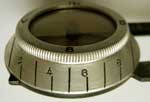 |
Box of the Typ 6 School compass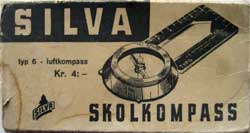 (For a view of the bottom click on the image) |
Model
"Type 7 NL" , small version
|
User instructions for Polaris
7 NL
and 4 S with exchangeable scales (see above) .  |
 Type
8 Forester
(1958 US catalog). Type
8 Forester
(1958 US catalog). Engravings on reverse: MADE IN SWEDEN ASSEMBLED IN USA BY SILVA INC. LAPORTE IND. and patents numbers for 5 countries (link to pic of back). The patent was filed by Nils Henry SANDBERG in 1953. It describes the method for mounting the capsule on the ruler. Scales: (1:24.000 & 1:62500) corresponding to 2000 ft/inch and 0.986 mile/inch.1958 |
| Model
11-S (1933) Compare to the NIFE & LYTH marching compasses   Pic. at right: export version (W-E) with 360 deg graduation courtesy K. Lucas |
UK Patent
472,794 - Figures  The Abbreviated company name SEIC stands for Svenska Elektro-Industri Companiet under the company's logo on model 11-S: The only user instruction known for the model above is a four-pages type-written French translation with glued drawings (link to picture). |
Technical
Data - Dim.: 70 x 68 x 20mm - Weight: 215gr - Divisions: 6400 mils, counter-clockwise, cardinals in Danish or Norwegian language (V-O) - Serial No.: 2094  Note
that SILVA's logo (a pine tree
behind the name on a band) is identical to the symbol
chosen in the patent figures for the object aimed at. Note
that SILVA's logo (a pine tree
behind the name on a band) is identical to the symbol
chosen in the patent figures for the object aimed at. Note also that silva is the Latin word for forest! |
| "Armékompass"
Model
1939*
(ancestor of the Type 15 Ranger below)  Technical Data - Dim.: 100 x 64 x 20mm - Weight: 13 gr - Divisions: 6300 streck/mils, clockwise plus 400 grades (gons) on the base plate rear face. - Serial no.: 20089 |
Reverse
side and detail
view of divisions
(North mark at 63oo Mils):
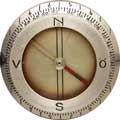 - Marking under the capsule: 8/53 (manufacturing month/year?) - dial on base plate rear face, - Parallel lines on bezel aligned on the N-S axis: scale from 0-10, figures 3, 5, 7 and 9 only engraved, total breadth: 50mm / 2 in. - Cardinals in Swedish language (N-Ö-S-V) |
*
NOTE: the
name Armékompass
is the item's designation in Swedish language The survey units in Sweden's Artillery use theodolites with the 400 grades (gon) division but the front observers and fighting batteries use the special MIL unit called streck (6300 units in a full circle). Source: Hĺkan Sahlin, Major, ret. |
| Type
15 Ranger (1950) Model 15 TD featured a declination adapter device  |
User
instruction (1970, view of cover, 22 p. copies available)  |
Description |
Type
16 - Trail Orienteering Compass for blind people |
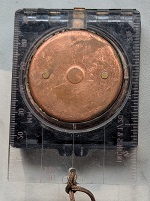 |
This
compass features Braille
cardinals for blind and visually impaired people. It is
the only
dry compass (without fluid) among the Silva range of compasses. The disc settles when the lid is closed, and is locked when the lid is opened. The main directions are felt with the fingertips. Size: 74 x 53 mm - Divisions: Braille signs show the cardinal points N, E, S, W. - Scales: mm and inches - Weight: 67g |

 Picture above, right:
The US Girl Scouts' logo Model Type 5 SILVA Jr. (or Pathfinder) of the US Girls Scouts (GS) See also Scoutism and (in Pocket compasses) a Compass Game for beginners. Technical Data - Dimensions: 76 x 50 x 14mm - Divisions: 360 deg. clockwise |
SILVA
founder
Björn
Kjellström's book Be
an Expert with Map and Compass
(1955) containing a
practising compass* and a map of Lake George's surroundings in the
Adirondack park (NY) with the camp on the shore. * see also LENSATIC and map & compass   (Click on the picture at left for a view of the practising compass and the map) |
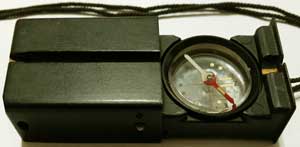

|
Type 25 PROSPECTOR This model is identical to the famous RECTA matchbox design - produced under licence or customized by Recta? See catalogues below |
| The
first compass made by SILVA U.S.A. (created after WWII) was
the Type
2 Voyager*
displayed in the 1950 catalogue. It was
marked 'Reg. Pat. Off.' i.e. Registered U.S. Patent Office.
In 1975, the U.S. Patent Office was renamed U.S.
Patent and Trademark Office. * The same compass model is called Typ 7 in the Swedish version. |

 1958 catalog of SILVA Inc. Laporte, IND |
 In the 1955
book, the Type 15 was called Ranger
and
the model called Explorer
was
almost identical to Type 2. In the 1955
book, the Type 15 was called Ranger
and
the model called Explorer
was
almost identical to Type 2. |
| An hexagonal-shaped compass called Type 21 Pioneer was created in (?) but apparently didn't offer any technical edge. On the contrary, its non-transparent base plate is rather a disadvantage. | 
 Ad and User instr. (click on img. for details) |
 Compass Game (modern version, check HERE the original version - manufacturer unknown). Click HERE for the game rules. |
 (Click on the pictures for enlarged views) |
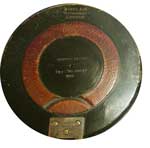 (Picture courtesy N. Godridge) |
Technical
Data - Dimensions (dia.): 3" / 75 mm - Weight: 450 gr - Card: with transparent rim (Barker's patent) - Divisions: 360° - Markings on reverse: see pic. at left. Compare with F. BARKER's models. |

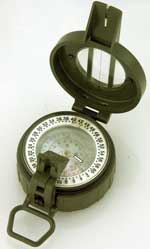 |
 The dial (Click on the pictures for enlarged views) |
 Technical
Data Technical
Data- Dimensions (dia. x height): 60 x 34 mm - Weight: 200 gr - Card: mother of pearl - Divisions: 60oo mills (Finland used the soviet system) - Illumination: tritium pads (under the prism and in sighting direction in the chapter ring) - Case: polycarbonate - Manufacturer's signature under the prism (pic. top right) - Pouch: synthetic leather, military green-grey (Click on link for picture) |

Model 1 |
Model 2 - Designer:
Valníček Pictures courtesy T. Hřebík - Click on the images for enlarged views |
Catalogue approx.
1930
(cover) |
Model 1 |
Model 2 Pictures courtesy T. Hřebík Click on the images for enlarged views |
Technical
Data - Divisions: 360 deg clockwise - Cardinals in Czech language (see menue Miscell./cardinals) - Ruler: 50 mm - Model 1 : Divisions printed on the face - Model 2 : Divisions printed on the crystal Model 1 featured on the obverse (see enlarged image) a unique list of military details concerning the shape and speed of military personnel Click HERE for Translation |
Army
version
(6400 Mils)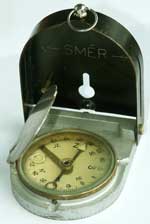 |

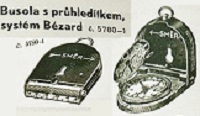 At right: drawing in catalogue Click on the images for enlarged views |
BÉZARD IMITATIONS Technical Data - Divisions: 6400 Mils clockwise - Weight: 3 oz. / 110gr The Army model features on both sides of the lid above the marching direction arrow the word SMĚR (Direction). Moreover, a S/N (?) 286 and the military unit 10 / 32 on either side of the symbol of the Czechoslovakian armed forces (lion in a lozenge). See also Bézard / Imitations / SMĚR and the pocket compass VTD. |
Civilian
version (360 deg.) |

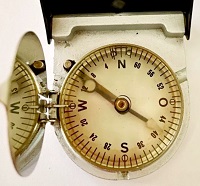 Pic at right: military version (6400 MILS) (Pic. crts. H. Waldmann) Left: The two versions of the ruler Top: milit. version, brass, 50mm, only 10mm engraved. Delicate figures, Bottom: civilian version: Aluminum, 50mm |
Technical
Data - Divisions: 360 deg., clockwise or 6400 Mills counter clockwise - Rulers 50 mm - Weight: 2 oz. / 75gr - The luminous arrow on each side of the lid is only a decal. The external one is less luminous than the inner one  |
 Former
British company (more information HERE).
See also WFS.
Former
British company (more information HERE).
See also WFS.Model
G150 - Preseries Pictures courtesy G. Ralph (Click on images for enlarged views) |
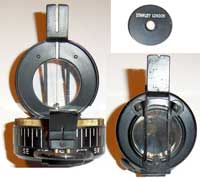 The case featured cardinals outside like on F. Barker & Son's model Mk III (see T.G. Co. Ltd London) |
Technical
Data - Dimensions: (length, closed) 88 x 58 (dia.) x 35 (height) mm - Weight: < 250 g - Card: Mother-of-pearl - Divisions: 6400 MILS or 360°, - Manufacture date: mid 1970's ? Version Armée Belge (pic court. T. Brink):  |
Model
G150 - Series (Click on images for enlarged views) |
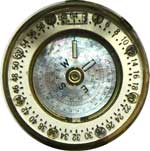 
|
Technical
Data - Dimensions: (length, closed) 88 x 58 (dia.) x 35 (height) mm - Weight: < 250 g - Card: Mother-of-pearl - Divisions: 6400 MILS - Tritium cells - Markings on reverse: S/N, mfr, NSN. (more details HERE) This instrument was maybe also sold under the brand name DOMINION. Compare with F. BARKER's models. |

 Picture www.trademarkondon.com - (Click on picture for enlarged views) |
Model
L1A1 This compass type was manufactured for only one month in the 1980s then discontinued. It’s roughly the same size as the G150, just weighs less, and has a different design. Stanley stopped making them very quickly for technical reasons (leakage problems - read the full story HERE) and continued with the G150. |
Technical
Data - Dimensions: . Max. length (excluding thumb ring): 88mm . Max width: 62mm . Max height: 38mm - Weight: approx. 200g - Material: brass case, aluminum clamp ring, mother of pearl dial, plastic pivot support inside brass bowl. - Calibration: 6400 MILS - NSN: 6605-99-531-2510 |


Officer's pattern Night marching compass (see note at r.) This
compass and
several others
appear in the book Military
Sketching Map
Reading and Reconnaissance
(click on the red book at right for a group view of four various
compasses)
|
'Verner
Compass' Mk
III Pictures courtesy Bob Thacker Click on images for enlarged views |
Technical
data -
Dim.: Ř 2 in (51mm) x 7⁄8
in (22mm) -
Dim.: Ř 2 in (51mm) x 7⁄8
in (22mm)- Manufactured 1897 Note: The simple luminous version was designated 'N.C.O.'s pattern'  |
Service
Pattern
Mark VI (Click on pictures for enlarged views) |
 
|
Technical
data - Dimensions . diameter: 2 3⁄32" (53 mm) . height: 7⁄8" (23 mm) - Weight: 150 gr - Serial no.: 11 - Compass card: aluminum and mica - Markings on reverse: A.H.S. - Pouch with belt loop  |

(Picture courtesy Nick Godridge) See also Taylor's pocket compass Ceebynite Technical data - MK III: see T.G. Co Ltd below - Service pattern: see Yeates below |
 Prismatic Service Pattern (1910s) (Click on the image for an enlarged view of the dial - Pic. courtesy N. Godridge) |
 Mark III prismatic liquid-damped compass with pouch (1940s) Instrument donated by Arbert ZUUR (www.heaterso.com) |
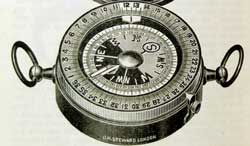 |
Pic.
at left: The liquid luminous Brigade Compass as published in the book The
Map & Compass A
practical modern guide to map reading and
the day and night use of modern compasses
by Captain J. Noel
(ca. 1940) Pic. at right: Cavalry School compass (link to ad) |
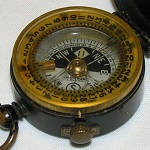 |
 Pictures courtesy of D. Robinson |
 
|
Prismatic
compass The case is almost identical to the lensatic instrument made by F. Barker & S. Technical data Dimensions: see Dollond Card: see Singer's pattern Marking: H.O. (Home Office?) crowfoot arrow head (British Army symbol) 27 = 1927? |

 German company (for
more information click HERE
and visit
its website).
C. Stockert's logo before WW1 featured a cane (Stock in German - see picture at right)
and two
letters S. Later, it was replaced with the name's initial letter (S)
inscribed in an elongated hexagon.
German company (for
more information click HERE
and visit
its website).
C. Stockert's logo before WW1 featured a cane (Stock in German - see picture at right)
and two
letters S. Later, it was replaced with the name's initial letter (S)
inscribed in an elongated hexagon.
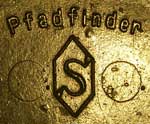 The first version of the model Pfadfinder (i.e. pathfinder, scout) featured a slot in the lid and no DRGM abbrev. The version shown in all catalogues and user instructions featured a mirror and a white face. |
The Pfadfinder
compass was slightly different from
BUSCH's Jungendienst-
Kompass
and featured a thumb loop which opened
the lid when rotated upwards (patent no. 476998). . . |
 Click on the image above for a description of this compass and of the three following models in the catalogue for 1938. Technical Data - Case: Bakelite - Lid: brass - Ring: nickel - Dimensions: 60 x 55 x 18 mm - Weight: 72 g |
Two
versions of
the Marschkompass
are known: the early one with a white chapter ring and a 50 mm ruler
and
the later one with a black chapter ring and a 100 mm ruler.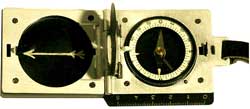 The Marschkompass was the official compass of the youth organisations (Hitler-Jugend etc.) Click HERE for a picture of a "Pimpf" (military Pathfinder) taking a bearing with a MKo. Below: Model "Touristen-Kompass" (see former definition of Tourist in MISCELLANEOUS/Terminology)  Later model with enamelled zinc cover plate and black chapter ring. |
Taking
a bearing
with the Marschkompass
 Below: View of the Marschkompass first version (see next row)  |
 The swivelling holding lever which equipped all compasses. Patent (1938) - click on picture for pdf view.  Technical Data - Dimensions: 60 x 55 x 20 mm - Case: Bakelite - Cover plate: aluminum or zinc, enamelled - Weight: 60 g (Marsch-Kompass) and 78 g (Touristen-Kompass) |
A
luxury early
version
of the Marschkompass
featured a red needle and a brass bezel (later
replaced by plastic).
The mirror had no sighting slot and the case no swivel lever. |
Detail
view of chapter ring and needle (Click on images for enlarged views) |
The
Magnetic North
reference was a tiny pin attached to the side wall
on the
early version but a protruding sharp edge of the scale on the later one. 
|
Upper
side of the "Marsch-Kompass" |
Upper
side of the
"Touristen-Kompass" |
User
instruction for the
three models (Pfadfinder-, Marsch- and Touristen- Kompass) |
| Model Marschkompass Jugend (Youth Marching Compass) Early definition (white scale, divisions counter-clockwise) 
 There were four different models (see prices above): with or w/o mirror, with normal or radium paint markings (pic. below r.). 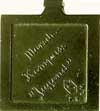  |
 Late definition (black scale, divisions clockwise). Simple model without mirror. The magnetic needle can be locked by means of a small brown lever.  |
 Box of the Jugend-Kompass: The text said on the old one (click to see it) that marching was more pleasant with a compass. After WWII, this word was replaced by hiking (Wandern). Technical Data - Dimensions: 50 x 50 x 13 mm - Case: Bakelite - Cover plate: Aluminum - Weight: 24 gr |
| Post
WWII
version of the KOMMIT
model (= komm' mit = "join in!")  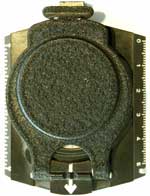 This lid shape is identical to a similar instrument made by PASTO |
 Back to ALPHABETICAL SEARCH (Marching Compasses) |
Technical
Data Dry compass with holding lever - Dimensions: 80 x 58 x 18 mm - Case: Bakelite - Lid: metallic, black paint - Weight: 65 g - Rulers: 50 mm and 2 in. - Divisions: 360 deg. clockwise in black, 6400 mils, counterclockwise, - Cardinal points: red. |
| The KOMMIT and PFADFINDER models in a modern fluid-dampened version. |
 The needle and the capsule were probably supplied by WILKIE. |
Technical
Data Modern fluid dampened version of the boy scout compass. - Automatic opening of the lid by turning the loop, - Folding grip lever. - Dimensions : 80 x 58 x 18 mm - Case: Bakelite - Mirror: metallic - Weight: 65 g - Rulers: 50 mm and 2 inches - Graduations : 6400 mils clockwise - Probably late 60's / early 1970's |
|
The Marschkompass
model in grey plastic case was available with dry or fluid
capsule. |
The
abbreviations D.R.P. and
D.B.G.M. on the obverse (see MISCELLANEOUS/ Terminology /
Abbr.), indicate a
probable production date in the late 50's or early 60's. The 'S' logo
doesn't appear on the liquid capsule version. |
Technical
Data - Dimensions: 70 x 60 x 22 mm - Casing: Plastic - Mirror: Metallic, enamel rear side - Weight: 77 g - Rulers: 50 mm and 2 in. - Divisions: 6400 mils, clockwise  |
| Moreover,
there was a large version (breadth: 65 mm; ruler, fully
opened: 130
mm). The early one (see
letter to the Heereswaffenamt,
dated 1940) featured a dry needle
capsule (6400
Mils,
counter-clockw.) in an Elektron
case painted black. The surface of the
external sides featured a grid of tiny "diamonds" (losenges) and the
only markings
are the usual logo (a small S in an elongated losenge above
the thumb ring axis) and the abbr. DRP at the opposite border. The later version featured a red fluid-dampened needle in a light alloy casing (6400 Mils, clockwise). The surface protection was a sort of "hammered" grey paint. The fluid damping capsule akin the KOMMIT model above was most probably supplied by WILKIE. A model featuring a clinometer and a bubble level was produced in 1980 with an olive drab case (Pic. courtesy F. Liebau). |

 Absolutely unique design: the compass capsule is integrated in a case made of two sliding halves (for photograph click HERE). |

Size comparison |
  Click
on pic. at right for enlarged view
|

 Rear face with logo (detail view at r.) and price (bottom, left) |
|
(Click for enlarged view) |
 |

|
Technical
Data - Dimensions : 72 x 55 x 20 mm - Weight: 80 g - Divisions: 360° - Compare with the item built by GURLEY |


Model
M.49 Distance measuring by means of the scales in MILS in the lid (Mesni ugao): the distance between eye and compass must be 50cm (20 in.) for the right-hand scale and 25cm (10 in.) for the left-hand scale. |
 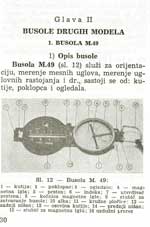 At right: description published in the 1969 Yugoslavia's army training manual. Three-side-view and parts as published in the 1972 maintenance manual. |
Technical
Data - Diameter: 60 mm - Depth: 20 mm - Weight: 100 g - Divisions: 6400 Mils Dial (see Miscellaneous/Cardinals, Serbo-Croatian)  |
Model
PO-52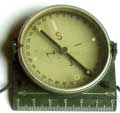 |
 Computing formulć on rear side |
Technical
Data - Diameter: 60 mm - Depth: 20 mm - Divisions: 6400 Mils - Dial: same as above, a luminous arrow on the bezel - No mirror |
Model
M-53  The capsule's ring is graduated in mils (6400) and the measured angle can be read at the underside in degrees. |
Three-side-view and parts as
published in the
1972 maintenance manual.  Measuring a vertical distance (Click for enlarged view) Drawing: Yugoslavian Army's manual - The sighting slots in the lid are graduated: “S+ 0 to 150” from the case’s base plate to the lid’s top on one side and respectively “S- 0 to 150” on the other side, to be read when holding the compass upside down. When holding it in 25 cm from the eye (a knot in the lanyard gives this distance), the observer can measure the distance between him and an object (whose size is known or estimated) and respectively, the distance between two points (if the distance to one of them is known) by means of the slots’ graduation and the artillery mils’ rule (1 unit = 1m at 1km distance). The total length (150 units could thus represent an angle of 1500 mils. |
Technical
Data - Dimensions: 70 x 63 x 16 mm - Weight: 130 g - Divisions: 6400 Mils - Markings: M53 / S71 Interesting compass built according to some principles of the Bézard. Both sides of the base plate show divisions in millimeters but no graduation. The lid has a short slot, in-line with the mirror’s sightline, and two luminous dots. The lanyard attachment ring also has a slot corresponding to the sightline and a luminous dot at its rear side, only visible in the mirror. The mirror’s sight line upper end is terminated by a triangular luminous arrow.  (Click on the picture to view the military manual's front page - photocopies can be ordered) |
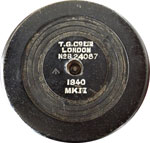
 Mk II and III Technical Data - Dimensions: 97 x 58 x 30 mm - Weight: 285 gr - Compass card: mother-of-pearl - Divisions: 360 deg., clockwise (Click on the images for enlarged views) |
Model
Mark III Picture at r.: click on image for description in British Army manual (1955) |
 Reproduction currently made in India. (read detailed entry HERE). |
| Model
MARK 1*
(1944) (* not to be mistaken with Barker's Mk1) |
COMPASS
MAGNETIC
MARCHING
Two different versions were produced: the quite rare and probably early one bore the full name "The Gramophone Company" (no. B6844). The more common and later one only bore the abbreviation. 
 (Pic. at left courtesy Dennis Sweet who made it possible to put a name on the abbrev.) |
Technical
Data - Dimensions: 70 x 65 x 25 mm - Weight: 150 gr - Divisions: 360 deg. clockwise - S/N : B17689 The users instructions were printed on a small square of paper the size of the mirror (copy available). Detail view of the dial: 
|



 This instrument
was made by Meiser
& Mertig in 1924 (engraved on
rear face on top of
the cities list). It is probably not connected to the motorcycles of
the
same name.
This instrument
was made by Meiser
& Mertig in 1924 (engraved on
rear face on top of
the cities list). It is probably not connected to the motorcycles of
the
same name. Pictures courtesy Mark Robinson (Click for enlarged views) The divider caliper is stowed in the hollow map reading tool |
Rear face: ruler folded with stowed divider. For a view of the cities' list with their west magn. declination starting with 0° in Goldap at the easternmost limit of East-Prussia (now Poland) click HERE. |
Technical
Data - Overall dim.: 74 x 13 x 5mm; compass dia.: 56mm - Weight: 120 gr - The hollow folding ruler is 74mm long with the removable divider stowed (70mm when the divider is removed); divider caliper: 47 x 10 x 2mm. The ruler is graduated up to 50mm and features map scales from 1:50,000 to 1:400,000 on one side (left column - pic. at left) and the corresponding line representing a certain distance in km (right column). Further scales on the sides: 1:25,000 and 1:40,000. 
 |
 (Click on images for enlarged views) |
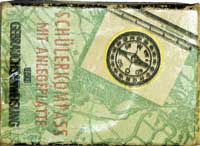  Box (front and side view) |
Technical
Data - Dimensions: 60 x 48 x 19 mm - Compass dia.: 40 mm - Ruler: 60 mm  Reverse of the user instructions |
 William Willoughby
Cole
Verner was born in 1852 and died Jan.
25, 1922 (for more information about his military career click HERE).
William Willoughby
Cole
Verner was born in 1852 and died Jan.
25, 1922 (for more information about his military career click HERE).|
Verner's Compass Patent (no rank is indicated. We couldn't find a Patent number) Pictures courtesy N. Godridge (Click on images for enlarged views) |
Captain W. Verner's Patent Compass |
 Major W. Verner's Patent, Night Marching Compass |
 Lt.-Col. Verner's N.C.O. Night Marching Compass (see picture here: Mil. Topogr. p. 45) |
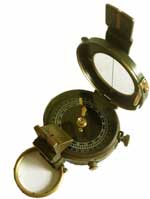 (Pictures courtesy A. Saukants) |
 Engraving on bottom (Click on the images for enlarged views) |
Verner's Pattern Mark VIII Technical Data - Dimensions (dia. x h.): 54 x 21 mm - Engravings on rear side: Vern.bus (+ S/N) Note: The website compasscollector.com cites black-face Verner compasses signed 'MIO'. User instructions : see our Shop (Short & Mason) |

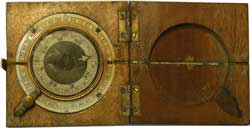 (Click detail view of dial) |
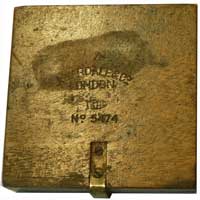 |
Technical
Data - Dimensions: 78 x 78 x 26 mm - Case: wood - Weight: 120 gr - Divisions: 360 deg. counterclockwise - Date: 1918 - Serial no.: 5474 |
| Mark IX (Click on images for enlarged views) |
Technical Data (same as Mk. VIII - see F-L) The Mk IX was identical to the Mk VIII but was not engraved with the inventor's name because the patent protection had already ended. - Date : 1935 Picture at right: compass signed by WATTS & HILGER |
 |
 Compasses issued to German soldiers between 1933 and
1945 are displayed in the chapters Breithaupt,
BUSCH,
MK, Zeiss Ikon, etc. See also the section Survey and Artillery
compasses (Breithaupt, Goerz, Zeiss,
"X"
(unknown manufacturer).
Compasses issued to German soldiers between 1933 and
1945 are displayed in the chapters Breithaupt,
BUSCH,
MK, Zeiss Ikon, etc. See also the section Survey and Artillery
compasses (Breithaupt, Goerz, Zeiss,
"X"
(unknown manufacturer). 
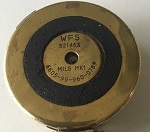 This
compass' NATO Stock No. 6605-99-960-0789 appears in a NSN reference table (link to spreadsheet)
as being a model M73 graduated in 6400 MILS (see F.
Barker) and having been made py PYSER-SGI but it is marked
MK1 and bears the
abbreviated Maker's name WFS i.e. William Ford STANLEY
(read the relevant entry)! Moreover, the
serial no. starts with a B for Barker. In an official NSN list the item
is called "COMPASS, MAGNETIC, UN" so that we must assume that it was
produced for the United Nations. There has probably been some
cooperation between F. BARKER and STANLEY for this procurement contract.
This
compass' NATO Stock No. 6605-99-960-0789 appears in a NSN reference table (link to spreadsheet)
as being a model M73 graduated in 6400 MILS (see F.
Barker) and having been made py PYSER-SGI but it is marked
MK1 and bears the
abbreviated Maker's name WFS i.e. William Ford STANLEY
(read the relevant entry)! Moreover, the
serial no. starts with a B for Barker. In an official NSN list the item
is called "COMPASS, MAGNETIC, UN" so that we must assume that it was
produced for the United Nations. There has probably been some
cooperation between F. BARKER and STANLEY for this procurement contract.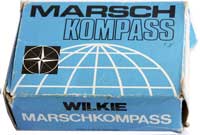
  The swivelling aft sight is identical to the prism fitting of the model PASTO 206 S and at the lowest point of the circular opening in the lid is a tiny triangle (fore sighting aid) (click HERE for picure of sighting).  Img at r. : Plain version w/o mirror and rotatable scale |
This
model doesn't appear in any of
the catalogues known and can as well have been designed and made by
PASTO. It was
propably an aborted project for the German
Army (Bundeswehr, Bw) created in 1956. The tiny arrow on the case's
left upper face is also on the Bw compasses made by Askania und
Breithaupt (CONAT). It is neither a lensatic nor a prismatic compass like the common items used by the U.S. Army (s. Stocker and Yale, Cammenga etc.) or the British Army (s. Barker, Stanley). Catalogue published by C. Stockert (1960s) : Click on image above for descr. in Engl. and on image below for a view of all prismatic models in the 1975 catalogue. 
|
Technical
Data - Divisions: 360° clockw. on the chapter ring and 6400 Mils clockw. on the capsule's bottom - Casing material: aluminum; colour: Military green; Side rulers: 50 mm and 2 Zoll; Lid: black - Dimensions (casing): 60 x 55 x 20 mm - Weight: 160 gr - Mirror: swinging downwards and automatically locking when deployed by 45°. On the rearside is a sticker featuring a table with, for a value in degrees, the corresponding width or distance of an object (ratio) and also a map measuring information (scales) (for picture click HERE ). - Magnetic needle: fluid dampened with Wilkie typical stabilizing winglets User Instruction in a WILKIE booklet with the typical logo (NATO rose of winds): Click on image above for full descr. in Engl. |
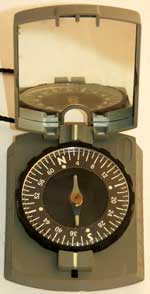 Model with grey case and only 6400 MILS divisions designated M 104 V in the 1968 catalogue but with a rectangular lid bearing WILKIE's logo (NATO rose of winds) and the abbr. DBGM on back side. User instruction in three languages (D / E / F). Early 1960's. |
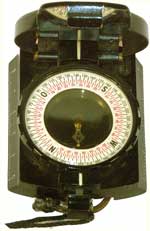
 Model M 105 F black (German catalog #). The export model with a flat lid-mirror catalog # was 500 (pic. at right, click on img. for full view of ad). Technical Data - Dimensions: 78 x 58 x 20 mm - Case: plastic - Weight: 50 gr |
 The magnetic needle looking as if only made of its northern half is in fact a blank part of a black disk. This design is also to be found on a light artillery compass without manufacturer name and on Wilkie's lapel compasses. Back to ALPHABETICAL SEARCH (Marching Compasses) |
| Marching
compass
model M 106 FC (catalogue for 1972)  |
 Sighting using the mirror |
 Technical data - Case: aluminium - Dimensions: 78 x 55 x 20 mm - Weight: 150 gr On the case of the German Army's models appears the word BUND (short for Bundeswehr). For picture click |
 The later models had a square lid with a NATO star logo Technical data - Case: metallic, black - Weight: 190 g |
 Here are the WILKIE's typical stabilisation winglets and the course setting tab at the underside well visible. |
 Some models had a tainted glass and a double scale |


Technical Data - Case: Metallic - Weight: 205 gr - Side rulers: 2" and 65 mm - Dim.(closed): 75 x 55 x 20 mm - Pouch: Leather imitation |

 This model with slope measuring device was a predecessor of the WILKIE MERIDIAN (Pro) survey compass. Description in the 1975 catalogue 
|
  The illumination of the capsule is adjusted by means of a serrated wheel on the side (compare to the Eschenbach electronic compass). The design was registered in 1972 by PASTO (DBGM Nr. 7243598). Pictures courtesy F. Liebau / Post editing by J.-P. Donzey |
 Pic. Robert Nicoud (Click for enlarged view) Technical Data - Model TOURING 11 (existed with and w/o mirror) - Dimensions: 105 x 60 mm ; compass diam.: 55 mm - Date: early 1970's - Dial: identical with survey compasses - Bilingual export version (engl./spanish) "Direction of travel / sentido de marcha" |
Technical
Data - Model TOURING 16 - Dimensions: 105 x 60 mm - Date: early 1970's - Instrument with a BILAND-type needle (with letters N and S).  (Detailed view of needle: click on picture) |
  |
 The compass card's rim is cup-shaped and points upward for easier reading  |
Technical
Data - Diameter: 50 mm (2 1/4") - Depth: 19 mm - Weight: 135 gr - Materials: steel case, brass ring and fitting - Divisions: 360 degrees clockwise - Card: decal of cardinal points and divisions on aluminium disk - Full length aiming slot in lid with a round hole in its centre and luminous paint on each side - Manual transit lock and momentary breaking lock (finger press dampener, see Verner's pattern Mk VII system). - Bezel: rotating march / bearing glass face with cross-shaped bar and rifle-type sighting aids.  |
 |
Technical
Data (No info - probably cheap asian production) |